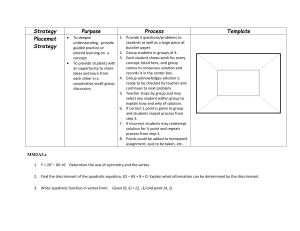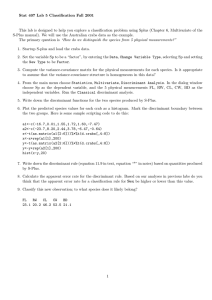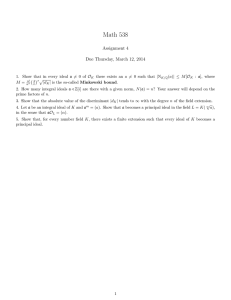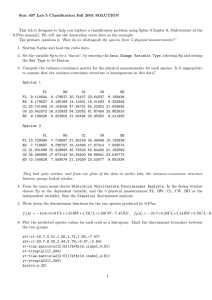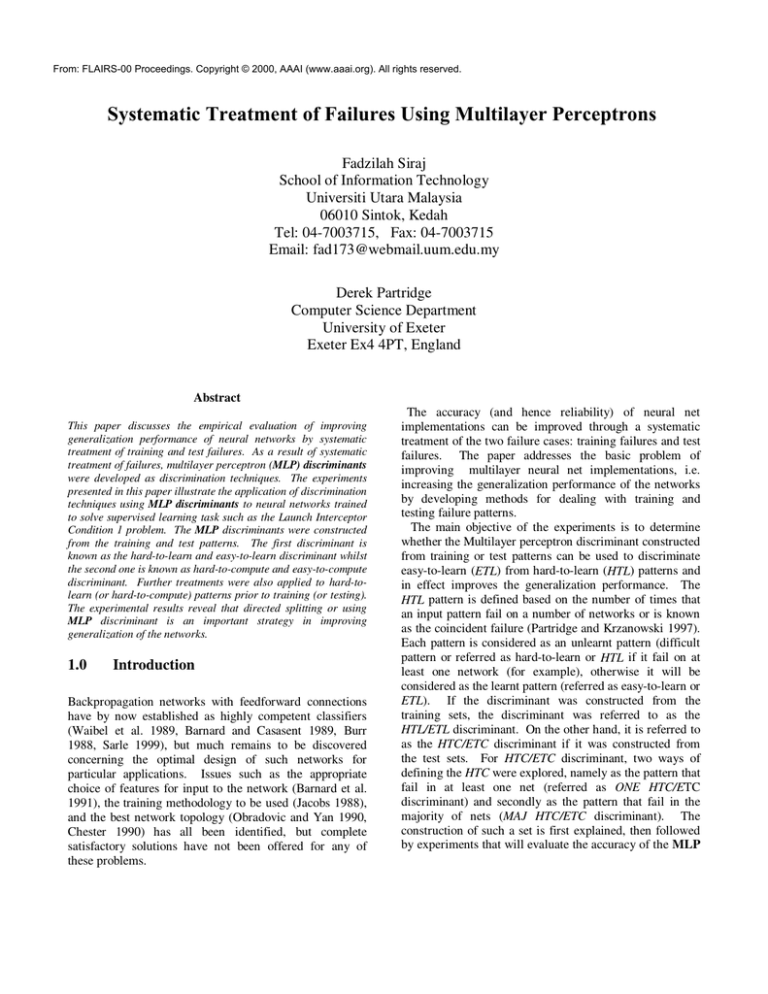
From: FLAIRS-00 Proceedings. Copyright © 2000, AAAI (www.aaai.org). All rights reserved.
Systematic Treatment of Failures Using Multilayer Perceptrons
Fadzilah Siraj
School of Information Technology
Universiti Utara Malaysia
06010 Sintok, Kedah
Tel: 04-7003715, Fax: 04-7003715
Email: fad173@webmail.uum.edu.my
Derek Partridge
Computer Science Department
University of Exeter
Exeter Ex4 4PT, England
Abstract
This paper discusses the empirical evaluation of improving
generalization performance of neural networks by systematic
treatment of training and test failures. As a result of systematic
treatment of failures, multilayer perceptron (MLP) discriminants
were developed as discrimination techniques. The experiments
presented in this paper illustrate the application of discrimination
techniques using MLP discriminants to neural networks trained
to solve supervised learning task such as the Launch Interceptor
Condition 1 problem. The MLP discriminants were constructed
from the training and test patterns. The first discriminant is
known as the hard-to-learn and easy-to-learn discriminant whilst
the second one is known as hard-to-compute and easy-to-compute
discriminant. Further treatments were also applied to hard-tolearn (or hard-to-compute) patterns prior to training (or testing).
The experimental results reveal that directed splitting or using
MLP discriminant is an important strategy in improving
generalization of the networks.
1.0
Introduction
Backpropagation networks with feedforward connections
have by now established as highly competent classifiers
(Waibel et al. 1989, Barnard and Casasent 1989, Burr
1988, Sarle 1999), but much remains to be discovered
concerning the optimal design of such networks for
particular applications. Issues such as the appropriate
choice of features for input to the network (Barnard et al.
1991), the training methodology to be used (Jacobs 1988),
and the best network topology (Obradovic and Yan 1990,
Chester 1990) has all been identified, but complete
satisfactory solutions have not been offered for any of
these problems.
The accuracy (and hence reliability) of neural net
implementations can be improved through a systematic
treatment of the two failure cases: training failures and test
failures. The paper addresses the basic problem of
improving multilayer neural net implementations, i.e.
increasing the generalization performance of the networks
by developing methods for dealing with training and
testing failure patterns.
The main objective of the experiments is to determine
whether the Multilayer perceptron discriminant constructed
from training or test patterns can be used to discriminate
easy-to-learn (ETL) from hard-to-learn (HTL) patterns and
in effect improves the generalization performance. The
HTL pattern is defined based on the number of times that
an input pattern fail on a number of networks or is known
as the coincident failure (Partridge and Krzanowski 1997).
Each pattern is considered as an unlearnt pattern (difficult
pattern or referred as hard-to-learn or HTL if it fail on at
least one network (for example), otherwise it will be
considered as the learnt pattern (referred as easy-to-learn or
ETL). If the discriminant was constructed from the
training sets, the discriminant was referred to as the
HTL/ETL discriminant. On the other hand, it is referred to
as the HTC/ETC discriminant if it was constructed from
the test sets. For HTC/ETC discriminant, two ways of
defining the HTC were explored, namely as the pattern that
fail in at least one net (referred as ONE HTC/ETC
discriminant) and secondly as the pattern that fail in the
majority of nets (MAJ HTC/ETC discriminant). The
construction of such a set is first explained, then followed
by experiments that will evaluate the accuracy of the MLP
discriminant as well as improving the generalization
performance.
To achieve the objective of the study, the first step is to
divide the patterns into two separate groups. The first
group of patterns will be used for training and testing. The
easy and hard-to-learn patterns will be selected from these
sets. The second group of patterns will also be divided into
training and test sets that will be utilized to evaluate the
performance of the MLP discriminant employed in the
experiments.
The MLP discriminant was constructed using the easy
and hard-to-learn patterns (or easy and hard-to-compute)
selected from the patterns of the first group. Several
combination of easy and hard-to-learn patterns are
explored in order to identify the composition that produces
the highest generalization.
Having determined the patterns, the next step is to
perform experiments which should give some insight to the
following plausible objectives:
1)
To determine whether separating and modifying
HTL patterns makes the patterns more learnable.
2)
To determine whether learning improvement
based on HTL/ETL discrimination leads to better
computational reliability (i.e. a reduction in the
number of wrongly computed results).
Once the HTL patterns were identified by the discriminant,
further treatments were applied to these patterns. For
modification purposes, normalization methods were
employed. The first normalization method is to sum the
squares of each parameter (i.e. x1, y1, x2, y2 and LENGTH),
take the square root of the sum, and then divide each
element by the norm (Bigus 1996, Cohn 1994 and Cohn
1974). This method is known as the Euclidean norm. A
second method of normalization is simply by dividing each
parameter by the parameter that has the largest value for a
particular pattern (Bigus 1996).
2.0
Methodology
The Launch Interceptor problem has been used in a
number of software engineering experiments concerning
correctness and reliability (see Knight and Leveson 1986,
Adams and Taha 1992). Partridge and Sharkey 1994, and
Yates and Partridge 1995 have applied the problem to
neural networks. This is a well-defined, abstract problem
that has been chosen to study since it offers a distinct
advantage of supplying numerous training and test patterns
with unambiguous outcomes. The problem involves an
anti-missile system, which is used to classify radar images
as indicative of a hostile missile, or not. The input for the
system represents radar images (specified as a sequence of
xy coordinate points) together with 19 real-valued
parameters and several small matrices which are used to
control the interpretation of the radar images. The output
is simply a decision Launch (when all 15 launch criteria
are satisfied according to certain conditions) or NoLaunch (when one or more of the 15 launch criteria is not
satisfied by the input data. The various criteria upon which
the decision depends are referred to as ``launch interceptor
conditions'' (LIC's). LIC1, the acronym from Launch
Interceptor Condition 1, is a boolean function that is true if
the Euclidean distance between two points is greater than
the value of another parameter LENGTH, and false
otherwise. The points are given as 2 pairs of x and y
coordinates (each in the interval [0,1] to 6 decimal places)
LENGTH is as single value in the same interval to the
same precision. Therefore LIC1 takes 5 input values i.e.
(x1, y1), (x2, y2), LENGTH and returns the value true or
false.
The results of prelimary studies show that training and
testing performance can be improved by modification of a
selected subset of patterns - ones with LENGTH <= 0.02,
ones with LENGTH approximately equal to 'distance',
those that fail to learn, and those that fail to test correctly.
However, detailed problem-specific knowledge has been
used to predict problematic patterns. In this study, the
experiments were performed to determine whether it is
possible to automatically predict (and to modify) these
'problematic' or HTL from ETL patterns using MLP
discriminants. The initial objectives are to construct a
'representative' set of hard-to-learn (HTL) and learnable
patterns, and to develop an MLP discriminant that can
recognises these within a general set of patterns. In
addition, the same idea with test sets, i.e. automatic
prediction of hard-to-compute (HTC) patterns are also
explored.
Three MLPs discriminants were constructed in the
experiments. The first discriminant was constructed using
the training patterns and it is known as the HTL/ETL
discriminant. The second discriminant was constructed
from the test patterns. From these patterns, the HTC was
defined in two ways. The first definintion of HTC refers
to test pattern that fails in at least one network out of 27
networks.
This discriminant is referred as ONE
HTC/ETC discriminant.
Another discriminant was
constructed by defining HTC as a pattern that fails in the
majority of networks. This discriminant is labelled as
MAJ HTC/ETC discriminant.
The approach has been stimulated from the empirical
studies conducted by Littlewood and Miller 1989 for
software engineering research and Partridge and Sharkey
1992, Partridge 1994, Partridge and Griffith 1995, and
Partridge and Yates 1996 from neural networks
experimental research. In conjunction with these studies,
MLP networks (Rumelhart and McClelland 1986) with 5
input units, 8 to 10 hidden units and 1 output unit (i.e. 5-81 to 5-10-1) are utilized in the experiments. Three training
sets (Set1, Set2 and Set3) are used to investigate the effect
of normalizing on the training and test patterns. Each
training set is composed of 1000 random patterns trained
using an online backpropagation algorithm with a learning
rate of 0.05 and momentum of 0.5. Sarle 1995 suggested
that sample size of 1000 is large enough that overfitting is
not a concern, so the results for 1000 training cases will
provide a standard comparison for generalization results
from small sample sizes. The weight seed number is
varied from 1, 2 and 3. Each MLP network is trained to
convergence (i.e. every pattern learned to a tolerance of 0.5
or 50,000 epochs for all training sets) whichever is first.
Based on the training results, the patterns were classified as
HTL or ETL patterns. As a result, some of these patterns
were randomly selected to form discriminant set of patterns
specifically for MLP discriminants. The performance of
the networks was tested on 10,000 test patterns.
2.
3.
Based on the results of the preliminary studies, it
is known that the arrangement of training patterns
for MLP training has an effect on the
performance of the network. When the HTL and
ETL subsets are constructed, there are not many
HTL patterns. Intuitively, if there are too many
ETL patterns, the networks may be trained to
learn these patterns only. Therefore, to minimise
the number of ETL patterns, we choose 3 of these
patterns for each HTL pattern. The patterns are
arranged in such a way that for every HTL pattern,
it will be followed by 3 ETL patterns. These
patterns are referred as the UNEQUAL set.
The same HTL is presented three times to each
ETL. This set is referred as SAME HTL set.
2.1 Constructing Discriminant Set
2.2
To construct a discriminant set, the previous 27 networks
trained on three raw training sets were used. Each set was
used to train 9 different networks (3 weight seeds x 3
hidden unit numbers), so there were nine attempts to learn
each pattern of the 1,000 in each training set.
Let n represents the number of networks in which a
pattern was not successfully learned, for example in
training; n can vary from 1 to 9. If the patterns were not
successfully learned in all the nine nets, then for an HTL
pattern, then n is set to 9. Consequently, n can be set to
8,7,1 until `enough' HTL patterns are obtained. On the
other hand, the ETL pattern is defined as the pattern that
learned by all nine nets (in this case, the total number of
network is 9). There are not many HTL patterns when
n=9. Therefore n is set to a smaller number. The
distribution of HTL patterns with respect to the number of
pattern that was not learned in k out of 9 nets. Note that
when n=5 for random training set Set1, the total of HTL
patterns is equal to the sum of patterns from k=5 to k=9
(i.e. 0+0+0+0+1 = 1). Thus, to get enough patterns for
each class, n is set to 1 (i.e. the sum of patterns from k=1
to k=9), and the composition of the random training sets
for discriminate technique is therefore comprises of 2982
ETL and 18 HTL patterns.
Several possibilities will be explored in order to
determine the training set composition that produced the
highest average generalization. In conjunction with the
chosen set the architecture for this particular set is
determined, as well as the number of epochs that produces
the highest average generalization. In effect, the `chosen
weight set' is obtained and this is utilized in the next
experiments as the HTL/ETL MLP discriminant.
In order to compare the discriminant techniques between
MLP discriminants, the pattern sets used for
discrimination purposes are also explored, viz:
1. A discriminant set is composed of the same
number of ETL and HTL patterns. This set is
referred as the EQUAL set.
Training and Testing
Having obtained, the MLP discriminants, several training
and testing methods were explored, namely:
(1)
The patterns are trained as MLPs without
applying any treatment to the HTL patterns.
HTL subset
Input patterns
Train MPLs
ETL subset
Figure 1: The procedure for obtaining HTL and ETL
subsets from training patterns of SRraw
(2)
Split and Separate
The HTL and ETL patterns are trained separately.
The HTL are normalized before training or
testing.
Modify
Input
Patterns
MLP
Discriminant
Train
HTL
% learnt
in total
ETL
Train
Figure 3: The procedure for obtaining the training
performance for the Split and Separate method.
(3)
The HTL and ETL patterns are trained separately
but the HTL patterns are not treated before
training or testing. This is known as the Split and
Separate method without any treatments.
Train
HTL
Input
Patterns
MLP
Discriminant
% learnt
in total
ETL
Train
Figure 4: The procedure for obtaining the training
perfomance by splitting the sets without treatment.
The experiments will be carried out in the same order as
the objectives listed in section 1.0.
4.0
Results
The generalization of multilayer perceptrons without
applying any treatments is 96.86%.
Clearly, the
generalization of all test methods exhibited in Table 1 are
significantly higher than the MLPs without any treatment
(p = 0.0). The Split and Separate method (without
treatment) that uses HTC/ETC discriminant constructed
from the UNEQUAL set achieved 100% generalization.
The normalized method (99.66%) whose HTC/ETC
discriminant was constructed using the EQUAL set
achieved the second highest result.
Like rational
discriminants, the MAJ HTC/ETC discriminants obtained
higher average generalization than ONE HTC/ETC
discriminants. Although the split and separate method
(without treatment) of ONE HTC/ETC constructed using
the EQUAL set converges faster than the first normalized
method of MAJ HTC/ETC, its generalization is 0.6% lower
than latter. Hence the assumption that MAJ HTC/ETC
discriminants produced higher average generalization is
confirmed.
Results exhibited in Table 1 also indicates that the MAJ
HTC/ETC discriminants achieved higher generalization
than ONE HTL/ETL discriminants. Although untreated
Split and Separate of ONE HTL/ETL constructed using the
EQUAL set converges earlier than the first normalized
method of MAJ HTC/ETC (600 versus 3389), the latter
obtained 0.27% higher generalization than the first
method. Thus, the generalization of the MAJ HTC/ETC
discriminants is higher than ONE HTL/ETL discriminants.
for training patterns would achieve higher average training
performance. As a result, the discriminant that obtained
higher χ2 value for the test patterns would yield higher
generalization performance. However, the ONE HTL/ETL
discriminant that produces lower χ2 value for test patterns
would yield higher average generalization performance.
5.0
Conclusion
The final findings from the experiments show that Split
and Separate method without any treatment is one of the
important training and testing method. Splitting method
inevitably requires more resources and may also speed up
the learning process. However, another question arises, is
simply random splitting can improve generalization
performance or is the directed splitting is more important?
To answer this question, 2 experiments on random splitting
methods were conducted on the same training and test sets,
and the results are reported in Table 2. The results show
that both random splitting methods affect the performance
of the networks. In fact, the performance becomes worst
than SRraw by at least 1.19%. Therefore the experimental
results indicate that directed splitting is an important
strategy in improving the generalization of the networks.
Testing (in %)
Split
50% to 50%
30% to 70%
Trainning
(in %)
99.88
99.82
Min.
Max.
Gen.
95.37
95.45
97.93
97.46
96.44
96.67
Table 2: The training and test results using random splitting
References
Adams, J. and Taha, A. 1992. An experiment in software
redundancy with diverse methodologies. In Proceedings of
the 25th Hawaii International Conference on System
Sciences, 83-90.
Barnard, E. and Casasent, D. 1989. A comparison between
criterion functions for linear classifiers, with an application
to neural nets. IEEE Trans. Syst., Man, Cybern. 19:10301041.
Barnard, E., Cole, R., Vea, M., and Alleva, F. 1991. Pitch
detection with a neural-net classifier. IEEE Trans. Signal
Processing 39:298-307.
Table 1: The random discriminant
The χ2 analysis reveals that the MAJ HTC/ETC and ONE
HTC/ETC discriminants which produces higher χ2 value
Bigus, J. P. 1996. Data Mining with Neural Networks.
New York, Mc-Graw Hill.
Burr, D. 1988. Experiments on neural net recognition of
the spoken and written text. IEEE Trans. Acoust, Speech,
Signal Processing ASSP-36:1162-1168.
Chester, D. 1990. Why two hidden layers are better than
one. In Proceedings of the International Joint Conferences
on Neural Networks, I-265-I-268, Washington, DC.
Cohn, P. 1974. Algebra: Volume 1. John Wiley and Sons.
Cohn, P. 1994. Elements of Linear Algebra. Chapman
and Hall.
Jacobs, R. 1988. Increased rates of convergence through
learning rate adaptation. Neural Networks 1(1):295-308.
Knight, J. and Leveson, N. 1986. An experimental
evaluation of the assumption of independence in
multiversion programming.
IEEE Trans. Software
Engineering 12(1):96-109.
Littlewood, B. and Miller, D. 1989. Conceptual modelling
of coincident failures in multiversion software. IEEE
Transactions on Softe\ware Engineering 15(12).
Obradovic, Z. and Yan, P. 1990. Small depth polynomial
size neural networks. Neural Computation 2:402-404.
Partridge, D. and Griffith, N. 1995. Strategies for
improving neural net generalization. Neural Computing
and Applications 3:27-37.
Partridge, D. and Krzanowski, W. 1997. Distinct failure
diversity in multiversion software. Technical report, 348,
Department of Computer Science, Exeter University.
Partridge, D. and Sharkey, N. 1992. Neural networks as a
software engineering technology. In Proceedings of 7th
Knowledge-Based Software Engineering Conference, Sept.
20-23, McLean, VA, USA.
Partridge, D. and Sharkey, N. 1994. Neural computing for
software reliability. Expert Systems 11(3):167-176.
Partridge, D. and Yates, W. 1995. Letter recognition using
neural networks: a comparative study. Technical report,
334, Department of Computer Science, Exeter University.
Partridge, D. Yates, W. 1996. Engineering mutliversion
neural-net systems. Neural Computation 8(4):869-893.
Rumelhart, D. and McClelland, J. 1986. Learning internal
representations by error propagation. In Rumelhart, D.,
Hinton, G., and Williams, R., editors, Parallel Distributed
Processing: Explorations in the Microstructure of
Cognition, volume 1, 318-362. MIT Press: Bradford
Books.
Sarle, W. 1995. Stopped training and other remedies for
overfitting. In Proceedings of the 27th Symposium on the
Interface.
Sarle, W. 1999. Neural Network FAQ, part 3 of 7:
Generalization, periodic posting to the Usenet Newsgroup
comp.ai.neural-nets, URL: http://ftp.sas.com/pub/neural/
FAQ.html.
Waibel, A., Hanazawa, T., Hinton, G., Shikano, K., and
Lang, K. 1989. Phoneme recognition using time-delay
neural networks. IEEE Trans. Acoust, Speech, Signal
Processing 37:328-339.




